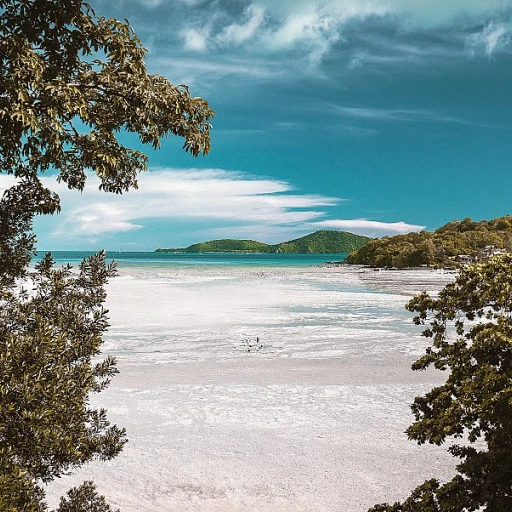The Allure of Australia's Peaks
Discover the Charm of Australia’s Majestic Mountain Peaks
Australia's peaks hold a unique allure, captivating climbers and adventurers with their majestic beauty and challenging terrains. With a landscape as varied as its wildlife, Australia offers a mountaineering paradise, from the snowy mountains in the south to the rugged ranges of the blue mountains. These diverse summits provide ample opportunities for alpine experiences that stretch one's mountaineering skills.
Exploring the untamed beauty of these heights is akin to exploring an uncharted territory. The distinct geology offers not only a test of physical endurance but also a climbing journey filled with breathtaking views and unique challenges. If you're passionate about the outdoors and eager for adventure, climbing Australia’s peaks may just be your calling.
While some may seek the icy slopes for a taste of ice climbing in the winter months, others may dream of a clear day ascent on Mount Kosciuszko, Australia's highest peak, where the alpine vistas stretch as far as the eye can see. Each season presents its own opportunities, from a winter ascent to summer climbs that promise blue skies.
Embarking on such journeys requires not only passion but preparation, from understanding local weather patterns to gaining essential mountaineering skills. It's about knowing when and where to climb, ensuring safety, and respecting the rich cultural heritage and natural beauty of each site.
To truly connect with nature, some enthusiasts even engage in snow camping or join an alpine academy to refine their skills. Whatever path you choose, exploring these pristine summits promises an unparalleled adventure. From the calming blue of Blue Lake to the stark white of a snowy landscape, each climb is a testament to the awe-inspiring power of nature.
Essential Gear for Australian Climbing
Equipping for the Climb
Embarking on an Australian mountaineering adventure requires careful preparation, particularly when it comes to assembling your essential gear. Whether you're eyeing the iconic summit of Kosciuszko or tackling the challenging blue mountains, having the right equipment is crucial for a safe and fulfilling experience.
The foundation of any successful ascent starts with robust climbing gear. Investing in quality hiking boots that provide ample support and grip is vital for tackling the diverse terrains you'll encounter. For those venturing into ice climbing in the higher altitudes of the Australian alpine, crampons and ice axes are non-negotiable essentials. Carrying insulated climbing gloves will protect you against frigid winds, especially during a winter ascent.
Your backpack should be spacious enough to accommodate items such as ropes, harnesses, and helmets. These are critical for ensuring safety as you navigate the climbing summits and rugged paths in a region like national park that challenges even seasoned climbers.
Layering is another key element when preparing for Australian climbs. Opt for moisture-wicking base layers, followed by insulating layers to ward off the chill of snow camping nights. Comprehensive protection against the elements is essential, from thermal outerwear to sun-resistant hats and sunglasses, especially when traversing the reflective surfaces of snowy peaks.
For those planning an extended adventure, ensuring that your gear is suitable for multiple days and nights of exploration is essential. Many climbers enroll in an alpine academy or take a course ahead of their journey to hone their mountaineering skills and ensure their equipment is up to the task.
As you prepare for your journey, remember that each piece of gear plays a role in not only facilitating your climb but in safeguarding your experience. With the right preparation, Australia’s majestic peaks await, ready to test your mettle and reward your perseverance.
Navigating Australia's Diverse Terrain
Conquering Diverse Australian Terrains
Australia's landscapes offer a fascinating array of challenges for mountaineers, from soaring peaks to icy slopes. As you navigate these terrains, each presenting its own unique characteristics, you'll hone essential skills that enhance your climbing experience.
The Snowy Mountains, a revered destination for Australian alpine pursuits, provide climbers with the thrill of ascending snow-clad peaks. In particular, the ascent of Kosciuszko National Park's summit is a test of endurance and ability. Throughout the winter season, the landscape transforms into a pristine wonderland, rewarding climbers with breathtaking views of snow-blanketed surroundings.
For those seeking a more technical climb, the ice-heavy regions of Victoria offer challenging ice climbing experiences. Equipped with proper mountaineering skills, adventurers can safely explore frozen terrains that require careful planning and execution. Engage in courses that cover the basics of mountaineering, ensuring safety as you tackle ice-clad cliffs and reach your desired summit.
The Blue Mountains, renowned for their spectacular scenery, invite climbers to experience world-class routes. Whether you're ascending the vertical walls of a climbing summit or setting up blue lake base camps for an overnight adventure, the opportunity to develop advanced skills is unparalleled.
When planning a climbing day in these national parks, it's essential to stay informed on weather patterns and their impacts. Ice and snow conditions can drastically change, requiring adaptability. Always consult local resources or visit Exploring Hidden Waterways: The Allure of Small River Boats for insights that can aid in crafting a secure climbing adventure.
Weather Patterns and Their Impact on Climbing
Understanding Australian Climatic Conditions
Australia's weather is as diverse as its terrain, presenting unique challenges for climbing enthusiasts. Climbers encounter varying conditions depending on the season and location, necessitating an adaptable approach to mountaineering skills. In the Australian alpine regions, winter ascent brings dramatic shifts with snow and ice becoming predominant elements. In the Snowy Mountains, you may face heavy snowfall, particularly around Mount Kosciuszko and Blue Lake. Here, ice climbing skills are essential, and snow camping becomes a necessary consideration during extended courses or multi-day climbs. Throughout a typical day, climbers in these regions might experience rapidly changing temperatures and unpredictable winds. High Velocity Snow (HVS) can impact the safety and success of your ascent, demanding a keen awareness of weather patterns and continual navigation adjustments. Venturing into the blue mountains during other seasons yields a milder yet equally challenging set of conditions. Climbs here can involve both wet conditions and intense sun, demanding proper gear and thorough preparation. Whether you are climbing summits in a national park or the Kosciuszko National Park, an introduction to mountaineering often involves understanding these weather variables. Comprehending Australia's weather patterns and their impact on climbing not only heightens safety but also enriches the mountaineering experience. As you hone your basic mountaineering skills, being cognizant of the weather's role in ascents, particularly the infamous Alpine Academy winter courses, becomes crucial to unlocking the adventure's full potential.Cultural Insights and Local Traditions
Cultural Encounters on Australia's Peaks
Exploring the majestic heights of Australian mountains is not just a test of your mountaineering skills or a physical challenge. It is also a journey into the heart of rich cultural heritage and local traditions. The Snowy Mountains and Blue Mountains stand as testament to this intertwining of nature and culture. Understanding the cultural significance of these peaks can enrich your mountaineering experience. Many of the peaks you will encounter, such as Kosciuszko within the renowned Kosciuszko National Park, hold spiritual significance for indigenous communities. These summits are often considered sacred, adding layers of depth to the adventure of climbing Australia's mesmerizing landscapes. As you navigate through diverse terrains—from the alpine stretches of Blue Lake to the snowy expanses of winter ascent courses—take the opportunity to learn about the traditional practices that have influenced Australian mountaineering. Engage with local guides or alpine academies that can provide insights into ancient customs and the historical narratives tied to the regions. The age-old practice of climbing does not stand apart from its environmental context. Sustainable mountaineering practices play a crucial role in preserving both the natural and cultural integrity of these regions. Respectful engagement with the land ensures that future generations will also experience the pristine beauty and rich heritage of Australia's alpine environments. Engaging with these cultural connections not only makes each climb more meaningful, but it also fosters a deeper appreciation for the mountains that challenge and inspire adventurers worldwide. Remember, as you embark on each day's climb or settle into a snowy base camp for the night, these mountains comprise more than just peak after peak—they are a significant tapestry of Australia's living culture.Sustainable Mountaineering Practices
Fostering Respect and Responsibility in Mountaineering
In pursuit of adventurous climbs on Australia’s captivating mountains, climbers are becoming increasingly aware of the need for sustainable practices. This awareness not only preserves the environment for future adventurers but also respects the land's cultural heritage and the ecosystems within it. While navigating the diverse terrain of Australia's mountains, including the iconic peaks of Kosciuszko National Park and the Blue Mountains, climbers are encouraged to embrace sustainable strategies, ensuring that the beauty of these landscapes is not diminished for future generations. Here are some considerations and practices to integrate into your mountaineering journey:- Leave-No-Trace Principles: Adhering to "leave-no-trace" principles is crucial. This means packing out all trash and minimizing physical impact on the landscape, which is particularly vital in sensitive alpine areas like Blue Lake.
- Respect Wildlife: The Australian alpine and national parks are home to diverse wildlife. Observing these magnificent creatures from a distance ensures that you don’t disturb their natural habits.
- Cultural Awareness: Many of the regions climbers explore hold significant cultural importance. Engaging with local traditions and communities not only enriches your experience but also emphasizes the cultural respect necessary while undertaking these endeavors.
- Eco-friendly Gear: Opt for sustainable gear choices. More brands are now providing eco-friendly options that reduce environmental impact without compromising on performance. Look for alternatives that support sustainability, whether you're ice climbing in winter or undertaking a summer ascent.
- Sustainable Travel Arrangements: When planning your expedition, consider environmentally-friendly travel options to reach your climbing destinations. Carbon offsets for travel and supporting local businesses can also contribute to a more responsible mountaineering experience.











-large-teaser.webp)
